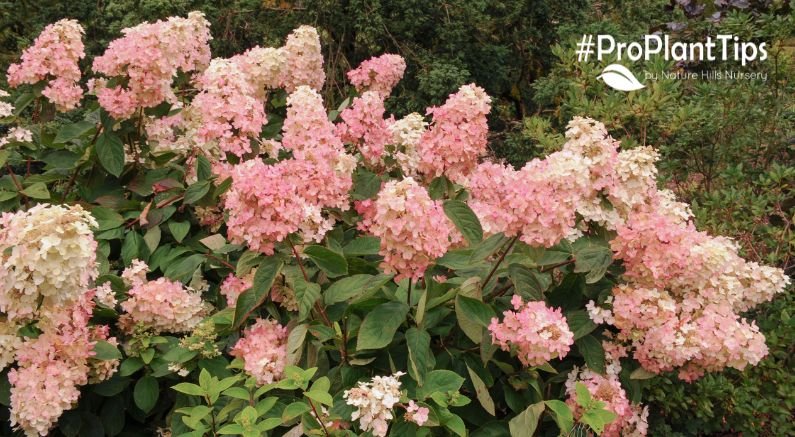Let’s look at the three woody types of Hydrangeas, how to best care for them, and what to expect from each.
Hydrangea paniculata types are the sun loving plants that have woody stems. This group currently up for sale from Nature Hills includes: Fire Light, Quick Fire, Little Lamb, Phantom, Vanilla Strawberry, Pinky Winky, Limelight, Strawberry Sundae, Little Quick Fire, Bobo, Little Lime, Silver Dollar, and Zinfin Doll.
This group all goes through the same transformation when it comes to the flower colors. Hydrangea paniculata types cannot have their flower changed from pink to blue by growing in acidic soils. No matter what the soils are, they start out with green leaves, flowers form later in June (most areas) and are green to start, open to white. Then as the flowers begin to age, they turn varying colors of pink and will vary wildly depending upon the site, sun exposure, location north and south in the different climates as to the time of year. Some turn very pink like Fire Light, Vanilla Strawberry and Zinfin Doll. The more sun these flowers receive, the more pink and red you will see on the plants. Eventually these flowers will turn brown and this entire transformation of color is normal and will happen each and every year.
Hydrangea paniculata types should be trimmed back by about one third of the size they are each spring before they start to grow - then leave them alone for the rest of the year. The tree form plants should be pruned back to a rounded form and again removing about one third of the size leaving a neat and uniform head when done. Remember pruning should be done in the spring before they start to grow.
Hydrangea quercifolia group, or the Oakleaf Hydrangeas, are woody shrubs that have peeling bark on the older stems, and elongated panicle flowers. The three selections that Nature Hills has available now include Gatsby Gal, Gatsby Pink, and Ellen Huff.
This group is hardy from zones 5-9 and do not perform well in zone 4. The colder zones may see some winter damage in less protected areas. They love full sun to part shade but need to have even moisture throughout the growing season. There is no color changing with this group of Hydrangeas by adjusting the soil pH, just nice pure white, very elongated panicle flowers. The white color fades from white to a light pink as the flowers age - no matter the soil pH. level.
They bloom on last year’s wood, so if you cut this one down to the ground you will not have any flowers that year. If you selectively remove a few of the older stems every couple of years right down to the ground, you will have flowers each year on the stems that you leave in place. The leaves resemble oak leaves in shape and in the fall, exhibit an incredible purple and red in fall and lasts for a long time. We have seen Oakleaf tolerate a lot of shade quite well, more so than most literature says it will.
Climbing Hydrangea is included because it is a Hydrangea. This is a climbing, woody vine that sits quietly for the first couple of years and once established then will start to put on some nice size. Hydrangea anomala petiolaris is the Latin name for this hydrangea a beautiful clinging vine that attaches to cement, brick, and wood. This woody vine produces lots of large, flat topped lacecap white flowers in June all over the plant. It is so very elegant and is used to cover unsightly or barren cement walls, and will attach to most any rough surface, including tree trunks where they can grow to be quite large. They like sun or shade and have beautiful shiny deep green foliage.

